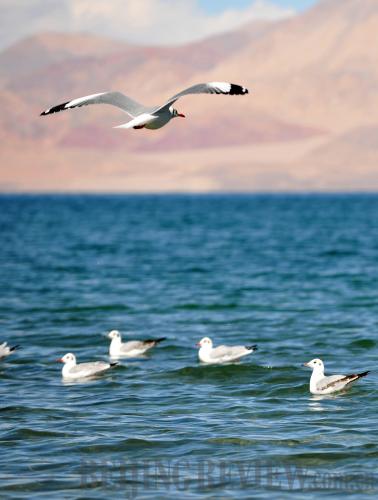|
 |
|
NATURAL HARMONY: Black-headed gulls look for food on Pangong Tso Lake in Ngari Prefecture, Tibet Autonomous Region, on October 20 (WEN TAO) |
Long Lived
A total of 58,789 centenarians are living in China, and the oldest is 128 years old, the Gerontological Society of China revealed on October 21.
Three quarters of the long-lived are women, and most of them are living in the countryside, the society said.
Provincial-level regions with the most centenarians are south China's Hainan and Guangxi and east China's Anhui, where the environment is good and the economy is "moderately developed."
The society found that most of the centenarians enjoy outdoor activities, are willing to communicate with others, and maintain a healthy diet.
Chinese people aged 60 and over had totaled more than 202 million by the end of 2013, or nearly 15 percent of the total population.
Pacific Buoys
China has completed a large-scale installation of submerged buoys in the West Pacific for the first time, a move essential to continuous observation of the ocean environment.
China's most sophisticated research vessel Kexue, or Science, returned to the eastern port city of Qingdao on October 21 after wrapping up an 82-day ocean expedition, during which it put 17 sets of submerged buoys in the key marine areas of the west Pacific and retrieved three, according to the Institute of Oceanology, under the Chinese Academy of Sciences (CAS).
It marks the first time that China has put an array of submerged buoys on such a big scale, said Hu Dunxin, a CAS academician. He said the research will help scientists better understand the relation between warm ocean in the West Pacific and climate change.
The expedition will also improve knowledge about the water and climate conditions of the west Pacific, said Yu Fei, chief scientist of the trip.
Kexue is expected to return to the marine area in mid-November to conduct a deep-sea environment project by the CAS.
Annual Pass
The Forbidden City in Beijing has started sale of one-year passes to better its service, according to a statement from the museum on October 21.
It is the first time the Forbidden City, also known as the Palace Museum, has issued annual passes.
An ordinary pass is priced at 300 yuan ($49), while passes catering to special groups including senior citizens and students cost 150 yuan ($24.5).
Pass holders will be eligible to visit the museum 10 times in a year, according to the statement.
However, in order to ease the traffic in peak season, the passes cannot be used during the seven-day National Day holiday, beginning on October 1, according to the statement.
Currently, a typical ticket costs 60 yuan ($9.8). | 